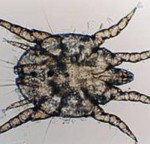Otodectes cynotis mites, most commonly known as ear mites are a type of mange and are more common in kittens and young cats, but can be found in dogs as well as other animal species. Happily for us though, ear mites do not affect humans. Mites are passed from moms to newborns or from pet to pet especially when sleeping and cuddling together, or grooming occurs; most noteably around the ear area. The most common symptoms you will notice include:
- shaking the head
- scratching the ears
- a coffee ground like debris inside the ears
- thick red-brown or black crusts around the top external portion of the ear
if the infestation is really bad you may notice
- your pet is painful when touched in the ear/ear canal areas (along side the base of the ear)
- some blood within the ear
- scratch marks and a loss of fur behind the ears
- crying when scratching
What can be done?
It is far more common and highly likely for your kitten to have ear mites than to not have them. Adult cats if recently acquired from a rescue or humane society or found stray may also have ear mites. Most often this is taken care of and treated on their first ever visit to the vet. It is much less common for puppies and dogs, often if their ears are bothering them they likely have another type of infection like yeast or bacteria, although they can definitely get ear mites.
The best, quickest and most guaranteed way to get rid of ear mites is to bring your pet in to see your veterinarian. Often mites can be diagnosed on physical exam, however your veterinarian will likely take a swab of the debris to check under a microscope and confirm the presence of ear mites and assess that no other infection is present. The ears are then flushed and thoroughly cleaned to remove all the mites and debris. Your pet will also be treated with a prescription medication to kill any remaining mites and prevent the infestation from recurring.
Be sure to let the vet know if you have other pets at home that spend a lot of time together or sleep in the same place as the pet that has mites. All those pets at home should also be treated to prevent mites from continuing to pass from one pet to the other. If the pet at home has a lot of debris in the ears, it is a good idea to bring them in to get their ears flushed as well. This is not something that should be done at home as you wouldn’t want to accidentally cause damage to the ear drum or ear canal.
Can you treat at home?
There is an over-the-counter treatment for ear mites, however if there is any uncertainty (especially in dogs) that the ear infection is mites, it is best not to use this medication. A downside to home treatment is that unless the ears are cleaned and the product is used exactly as directed, including the repetition of the medication a few weeks later, it may not resolve the problem completely, resulting in the same issue for your pet a few weeks down the road as the mites continue to re-infest the ears. We have also had clients who used the product exactly as directed and it still did not resolve the problem.
The great thing about mites is that they are fairly easy to get rid of and don’t often recur when done with the aid of your veterinarian. If you have any questions about ear mites, your pet’s potential ear infection or anything else related to your pet’s health please contact your veterinarian.

Ear mite seen under a microscope.



